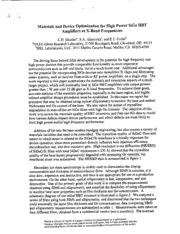
NASA Technical Reports Server (NTRS) 20000056042: Materials and Device Optimization for High Power SiGe HBT Amplifiers at X-Band Frequencies PDF
Preview NASA Technical Reports Server (NTRS) 20000056042: Materials and Device Optimization for High Power SiGe HBT Amplifiers at X-Band Frequencies
Materials and Device Optimization for High Power SiGe HBT Amplifiers at X-Band Frequencies C.H. Mueller a, S.A Alterovitz a, and E.T. Croke b "NASA-Glenn Research Laboratory, 21000 Brookpark Road, Cleveland, OH 44135 _rIRL Laboratories, LLC, 3011 Malibu Canyon Road, Malibu, CA 90265-4799 The driving force behind SiGe development isthe potential for high frequency and high power devices that provide comparable functionality as more expensive semiconductors such as InP and GaAs, but at a much lower cost. Additional advantages are the potential for incorporating SiGe devices onto monolithic Si chips and fabricating entire systems, such as receiver front-ends or RF power amplifiers, on a single chip. The work reported in this paper summarizes the materials and simulation aspects era much larger project, which will eventually lead to SiGe HBT amplifiers with output powers greater than 1W and over 35 dB gain at X-band frequencies. To achieve these goals, accurate analysis of the materials properties, especially in the base region, and highly refined amplifier design procedures must be established. In this paper we report the precision that may be obtained using optical ellipsometry to monitor the base and emitter thicknesses and Ge content of the base. We also report the extent of crystalline degradation in state-of-the-art SiGe films with high Ge contents. The objective of this work is to access the materials quality of HBT structures, and then use this data to model how various defects impact device performance, and which defects are most likely to limit high power and/or high frequency performance. Addition of Ge into the base enables bandgap engineering, but also creates a variety of materials variables that need to be controlled. The crystalline quality of SiGeC films and extent to which strain is relaxed at the SiGeC/Si interfaces is critically important for device operation, since these parameters directly influence hole injection efficiency, recombination rate, and thus transistor gain. High resolution x-ray diffraction (HRXRD) of SiGeC/Si films with total SiGeC thicknesses_ 250 tt,) showed that the crystalline quality of the base layers progressively degraded with increasing Ge contents, but interracial strain was maintained. The HRXRD data is summarized in figure 1. Secondary ion mass spectroscopy is widely used to characterize the doping concentration and thickness of semiconductor films. Although SIMS is accurate, it is also slow, expensive and destructive, and thus is not appropriate for use in a production environment. On the other hand, opti_al ellipsometry is fast, inexpensive, and non destructive. One of the primary goals of this work is to compare the measurements obtained using SIMS and ellipsometry, and establish the feasibility of using ellipsometry to monitor base layer properties such as film thickness and Ge concentration. A schematic diagram of our initial HBT structure is illustrated in figure 2. We analyzed a series of films using both SIMS and ellipsometry, and discovered that the two techniques yield essentially the same film thickness and Ge concentrations; data comparing SIMS and ellipsometric measurements are summarized in table 1. Measurements were taken on four different films, obtained from a commercial vendor (not a coauthor). The nominal This isa preprint or reprint of apaper intended for presentation at aconference. Because changes may be made before formal publication, this ismade available with the understanding that itwill not be cited or reproduced without the permission of the author. emitter and base thicknesses for each film were 2000 A and 200 A, respectively, but the actual thicknesses varied. We conclude that ellipsometry is a highly useful tool for monitoring the layer thicknesses andGe contents of HBT structures. Furthermore, SiGe processing for high Ge content films is still a sufficiently difficult process that monitoring of film quality is required in order to achieve high power, high frequency devices on a routine basis. O00 .... I .... I .... I .... I .... 2O I000 A Si:P emitter cap= _l-P]=2xl019 cm"3 _¢,00 1, | 1000 A Si:P emitter laver. IPl=lxl0 _scm3 _. 500 .._.9..._k._s..i._:._._._,_,..c...o.,..._...s..P....a....c.._....r......._....e....r... 10 ;_ 200 A Sio.74sGeo.zsCo.oo[2B,]=Sx1019 cm"s I 50 A Sio.74sCreo._Co.oo2spacer layer 5 2 5000 A Si:P collector layer, [P]=lxl017 cm"3 IO0 1p.mSi:Psubcollector, [P]=2x1019cm'3 0 5 2O 25 Figure 2. Schematic layer thicknesses, nominal Ge Figure 1. High resolution x-ray concentration, and doping levels diffraction full-width, half maximum for SiGeC HBT structures. values and percent relaxation at the Si/SiGeC interface as a function of Ge content. Table 1. Comparison of ellipsometry and SIMS results. Sample _i, 2_ tsic_(FWHM), A Ge cone., at. % Nominal SIMS Ellips. Nominal SIMS Eiiips. Nominal SIMS Ellips 1 2000 2435 2519 300 255 231 25 20 21.2 2 2000 2415 2516 300 317 332 25 20.8 20.2 3 2000 1430 1493 300 234 208 25 23.2 24.4 -- 4 2000 -1505 1659 300 280 255 25 23.4 22.8
